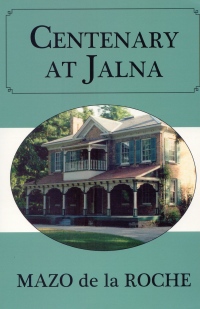| ________________
CM . . .
. Volume XVIII Number 41. . . .June 22, 2012
There is an odd madness that author Mazo de la Roche bestows on her characters. Their hyper emotional behaviours and skewed view of the world fit perfectly within the gothic romance genre, but, for the reader, their often bizarre and repressed behaviours will be disturbing. To enjoy this book, the reader must be an aficionado of sweltering prose that obsessively focuses on death and blood:
For a follower of de la Roche’s work, the novel continues the saga of the Whiteoaks which relied heavily on metaphors of overgrown nature and comparisons of people to houses that was a mainstay of both the Brontes’ writing and de la Roche’s earlier installments in this series, and this book will not disappoint. The novel firmly fits into the Southern Ontario gothic tradition of narrative. The lives, emotions, and generations that live in the Whiteoak’s household are as overgrown and intertwined as the foliage and vines metaphors in the text:
There is even a miniature version of the young Heathcliff in the character of the boy Dennis. His behaviour, in real life, would qualify him as a psychopath. In de la Roche’s novel, he is just seen as merely high strung by the other characters. Among his dubious acts, Dennis delays telephoning for a doctor when a woman goes into labour:
Death, madness, and strange behaviour afflict young and old in this novel. Young Mary, who is a deeply disturbed child, whispers on several occasions to a new born, “You’re prettier than a spider,” she said, “sweeter than a rose.” (p. 307). This story, set in 1953, is ripe for parody such as in the manner of Abraham Lincoln: Vampire Hunter and Pride and Prejudice and Zombies due to its heavy handed prose, shrill emotions and ever present overt and covert violence. It has both a racist and misogynist tone that will offend some readers. While the earlier novels in the series could be said to provide some sense of how Canadians lived in an earlier era, this book does not have that redeeming feature. Not recommended. Located in Toronto, ON, J. Lynn Fraser is an author and freelance writer. She writes for national and international magazines, non-profits, and corporations.
To comment
on this title or this review, send mail to cm@umanitoba.ca.
Copyright © the Manitoba Library Association. Reproduction for personal
use is permitted only if this copyright notice is maintained. Any
other reproduction is prohibited without permission.
NEXT REVIEW |
TABLE OF CONTENTS FOR THIS ISSUE
- June 22, 2012.
AUTHORS |
TITLES |
MEDIA REVIEWS |
PROFILES |
BACK ISSUES |
SEARCH |
CMARCHIVE |
HOME |
